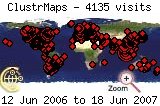early morning in lab:

four Moorhuhn2 addicts - this is where I picked up e game:

[160702] went to Tokyo & Nikko National Park right after my honours exams in May 2002. stuff about e trip's [to be done].
[311002] what I made for my sis for her 22nd bday on Tue 22nd Oct 2002: she cut e birthday cake at 22:22:22pm =) made it in school & carried it over to Arts fac in a big fat black garbage bag that attracted plenty of stares from people on e internal shuttle bus!!

[201102] W.H.Y. crabs/prawns/lobsters turn red when cooked: their shells contain two pigments, blue (crustacyanin) & yellow, which together give e shell a greenish color. both pigments are proteins with e same carotenoid prosthetic group, astaxanthin. interaction of e crustacyanin protein with e red carotenoid causes it to appear blue due to some chemistry that I don't understand =) cooking e crab/prawn/lobster denatures e protein, releasing e red astaxanthin....only if some similar 'indicator' could be incorporated into all sorts of food to make it easier to determine if e food has been thoroughly cooked, much like e way we use pH indicator dyes & autoclave tape in labs?
- inspiration from reading Ann Rev Biochem 1997 vol 67:1-18 just before lunch
[311202] e URA Parks & Waterbodies & Rustic Coasts Plan subject group - experiment with S'pore civil society. picture taken at House No. 1, Tanjong Chek Jawa during our field visit to Changi Village, Pulau Ubin, Coney Island & Punggol:

[311202] after clearing up most of e evidence of our secret Christmas party (boss was overseas) *grin*

[ filed under: 9_lives_2002 + labrat + nature1 + thewonderingstraycat ]





